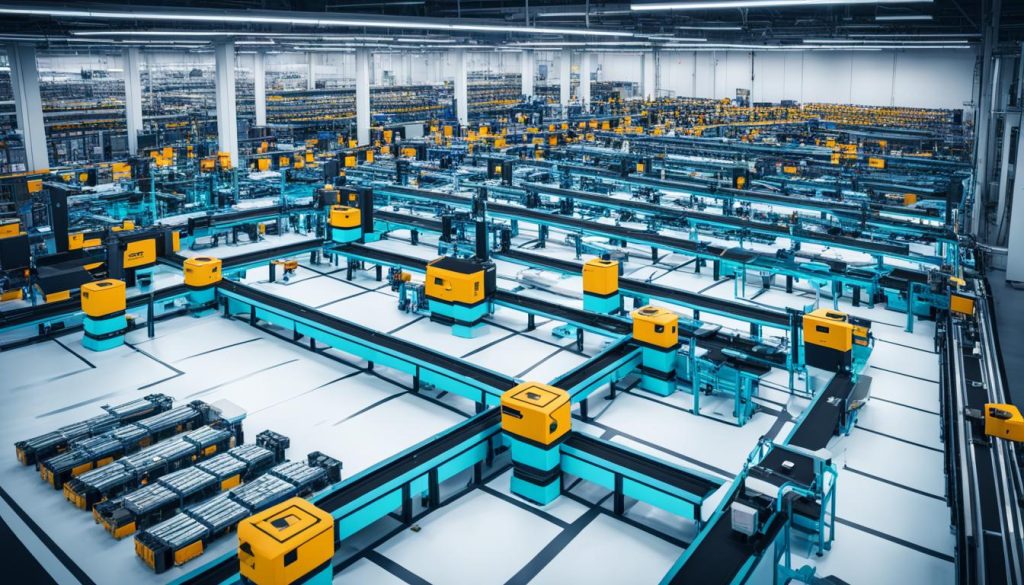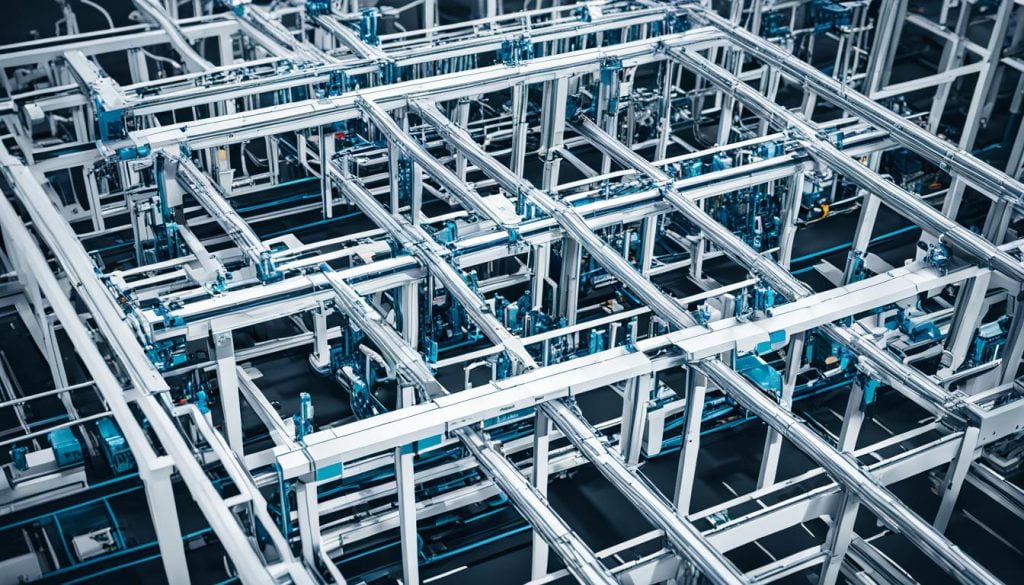As global markets continue to evolve, your ability to maintain a robust supply chain in the manufacturing industry has never been more pivotal. An uptick in external disruptions has underscored the necessity of supply chain resilience in manufacturing. A resilient supply chain is not just about surviving the immediate effects of a disruption but also maintaining the capacity for rapid recovery.
Your strategies for enhancing manufacturing supply chain resilience are crucial in today’s business landscape. They involve the cultivation of supply chain agility in manufacturing to circumvent the complications caused by unforeseen events. Agile practices allow for a dynamic response, minimizing the idle time and ensuring continuous production flow. Furthermore, retaining a focus on manufacturing disruption mitigation can mean the difference between a slight setback and a catastrophic business failure.
It’s in your strategic interest to embrace a framework aimed at reinforcing the robustness of your supply chain. Let’s delve into what enables a manufacturing operation to withstand the tremors of the unpredictable global economy and thrive amidst the challenges that lie ahead.
Key Takeaways
- Understanding the criticality of resilience in today’s manufacturing supply chain.
- Exploring strategies to reinforce and enhance the agility of your supply chain operations.
- Emphasizing the imperative of proactive disruption mitigation plans.
- Highlighting the roles of flexibility and innovation in overcoming supply chain adversities.
- Encouraging a comprehensive assessment for continuous improvement in supply chain resilience.
Understanding the Importance of Resilient Manufacturing Operations
As you navigate the complexities of the manufacturing landscape, understanding the fundamentals of resilient manufacturing operations becomes non-negotiable. Historical disruptions have left indelible marks on the sector, underscoring the need for building resilience in the manufacturing sector. Recalling significant past events, it’s clear that without resilient frameworks, companies faced setbacks from which recovery was painstakingly slow.
The contemporary manufacturing terrain, rife with the pressures of globalization and the unpredictability of climate change, demands robust manufacturing resilience strategies. For instance, consider how just-in-time production systems, while efficient, can become choked by global supply chain issues, or how extreme weather events, amplified by climate change, can lead to costly halts in production.
Peering into the future, it is evident that resilience will be the cornerstone of enduring manufacturing operations. The dynamic nature of technological advancement, coupled with geopolitical uncertainties, further cements the need for ongoing innovation in supply chain strategies. The key is not just to survive the next challenge, but to emerge stronger and more adept.
Consider resilience not just as a defensive strategy, but as a competitive differentiator that can elevate your business. By weaving resilience into the fabric of your operations, you ultimately ensure that when the next disruption strikes—and it will—your company is prepared not just to withstand, but to evolve.
The Role of Supply Chain Risk Management in Manufacturing
As vital links of the global economy, manufacturing operations must navigate a labyrinth of potential disruptions. Supply chain risk management (SCRM) has emerged as a lifeline for these operations, ensuring continuity in the face of uncertainties. Let’s explore the key components of SCRM and uncover how they fortify the backbone of the manufacturing sector.
Identifying Key Risks in Manufacturing Operations
Manufacturing leaders acknowledge that the first step in effective supply chain risk management is identifying key risks that could impede operations. Common risk factors such as supply shortages, economic fluctuations, and political instability require keen attention. Metrics such as supplier performance, cost volatility, and geopolitical climate serve as indicators that can preemptively flag potential issues. By mapping these risks, manufacturers can devise informed strategies to mitigate them proactively.
Strategies for Effective Risk Management
When it comes to strategies for effective risk management, a multidimensional approach is indispensable. Elements such as supplier diversification, inventory buffer strategies, and robust communication channels across the supply chain play pivotal roles. Equally crucial is the agility to adapt plans when the landscape shifts unexpectedly. Here’s a glance at several time-tested strategies employed by leading manufacturers to shield their operations:
- Risk Assessment and Response Planning
- Supplier Relationship Management
- Demand Forecasting and Capacity Planning
- Investments in Redundancy and Flexibility
Gearing up for these challenges entails not merely recognizing but deeply understanding the intricate weave of factors that dictate the stability of manufacturing operations.
Technological Solutions for Risk Mitigation
In the arena of technological solutions for risk mitigation, cutting-edge advancements have opened new avenues for manufacturers. Innovations like the Internet of Things (IoT) and blockchain technology are now at the forefront of the battle against supply chain unpredictability. IoT devices offer real-time tracking and monitoring, while blockchain introduces new levels of transparency and security. The table below illustrates the impact of various technologies on supply chain risk management:

| Technology | Application | Benefit |
|---|---|---|
| Internet of Things (IoT) | Real-time asset tracking | Enhanced visibility and proactive issue resolution |
| Blockchain | Secure transactions and data sharing | Increased trust and reduced fraud |
| Big Data Analytics | Risk pattern identification and predictive analytics | Informed decision-making and operational efficiency |
| Artificial Intelligence (AI) | Automated risk assessment and response actions | Swift and intelligent risk mitigation |
| Cloud Computing | Scalable data storage and collaboration tools | Improved resilience and reduced downtime |
By implementing these technological measures, manufacturers are not just combating current threats, but also paving the way for a more resilient future within the intricate web of global supply chains.
Building Resilience in the Manufacturing Sector: A Proactive Approach
The manufacturing landscape is continually evolving, and with these changes come new challenges. Building resilience in your sector requires not only identifying current weaknesses but also investing in the future. Let’s explore the pathways to create a buffer against the unexpected and ensure a thriving, sustainable future for manufacturers.
Assessing the Current State of Resilience
To gauge where you stand in terms of resilience, consider conducting thorough assessments that reveal vulnerabilities in your resilient supply chain practices. This could involve stress-testing your systems and scrutinizing your response to past disruptions. With these insights, you can prioritize areas needing immediate attention or further fortification.
Planning for Long-Term Resilience and Sustainability
Future-proofing your operations demands a blueprint for long-term resilience and sustainability. This means embracing eco-friendly practices, diversifying suppliers, and forecasting potential scenarios to stay ahead of risks. An agile plan is your roadmap through the unpredictable, keeping you competitive and resilient.
Investing in Workforce and Skills Development
At the core of a robust manufacturing sector lies a well-trained, adaptive workforce. By investing in workforce and skills development, you are ensuring that your team is equipped to handle new technologies and methods, keeping your operations resilient in the face of change.
| Key Resilience Component | Assessment Technique | Investment Strategy |
|---|---|---|
| Supply Chain Diversification | Scenario Analysis | Strategic Alliances and Local Sourcing |
| Technological Adaptability | Innovation Audits | Continued IT Training and R&D Investment |
| Workforce Readiness | Skills Gap Analysis | Employee Development Programs |
| Eco-sustainability | Environmental Impact Assessments | Green Initiatives and Renewable Energy Integration |
Supply Chain Resilience in Manufacturing: Adapting to the Unpredictable
In today’s manufacturing landscape, improving supply chain flexibility is not just an advantage—it’s a necessity for manufacturing disruption mitigation. You’ve seen the headlines: factories shuttered, shipments delayed, and customers scrambling. It’s a domino effect where a single hiccup can send ripples through the global economy. But amidst these challenges, there are manufacturers who stand out for their resilience. These organizations have transformed adversity into opportunity, proving that agility in the supply chain can spell the difference between succumbing to the chaos and emerging stronger than before.
Take, for example, the approach of global corporations such as Toyota or Intel. These industry leaders have demonstrated time and again that a proactive stance on supply chain management can yield substantial dividends when faced with the unpredictable. Their rousing success is grounded in an adaptive supply chain strategy, informed by real-time data and powered by advanced forecasting tools.

But what can your manufacturing business learn from these titans? Let’s distill their experiences into tangible strategies through a table of case studies that underscores the pivotal elements of flexibility and adaptability.
| Company | Disruption Faced | Flexibility Strategy | Outcome |
|---|---|---|---|
| Toyota | 2011 Tohoku Earthquake | Just-In-Time (JIT) + Risk Diversification | Quick Recovery, Maintained Production Levels |
| Intel | Global Chip Shortage | Strategic Inventory Management | Stable Supply, Competitive Advantage |
Notably, thought leaders in supply chain management like Hau Lee of Stanford University advocate for a trifecta of agility, adaptability, and alignment. You can leverage these principles to reimagine your supply chain resilience. Agility enables you to respond rapidly to immediate changes, adaptability equips you to adjust your configurations to long-term market shifts, and alignment ensures that your entire supply chain is synchronized with your business strategy.
“Flexibility is the new cornerstone for modern supply chains,” suggests Hau Lee. “The ability to swiftly adapt to unforeseen circumstances can be the make-or-break factor in today’s volatile market.”
As you steer your manufacturing enterprise through the labyrinth of global uncertainties, let the success stories of those who’ve adeptly navigated disruptions guide your path. Implementing a robust flexibility framework isn’t just about survival—it’s about setting up your business to thrive in the face of the unpredictable.
Conclusion
As you’ve traversed the complex landscape of supply chain resilience in manufacturing, it’s become clear that the robustness of operations is not just desirable but essential. The strategies and insights presented here hold the key to manufacturing resilience, ensuring that your operations are not merely surviving disruptions but thriving in spite of them. Through a combination of anticipation, swift adaptation, and persistent innovation, resilient supply chain practices become the bedrock of a flourishing manufacturing sector.
In summarizing the golden threads of manufacturing resilience strategies, recognize your capacity to preemptively combat manufacturing disruptions. With prudence and foresight, cultivate operational stability that can withstand the trials of a volatile market. Shaping a resilient manufacturing operation integrates agility across all facets of your supply chain, embedding flexibility at the core of your processes. The culmination of these efforts aligns with a burgeoning industry ethos that prioritizes resilience as the cornerstone of sustainable growth.
Upholding these resilient supply chain practices sets a promising trajectory for the future of manufacturing. As you step forward, carry with you the essence of these learnings — resilience is not a fixed state but a continuous journey. Each step towards enhancing resilience is a stride towards a future marked by unwavering solidity, boundless innovation, and sustainable advancement. Equip yourself with unwavering resilience and stand at the forefront of an agile, dynamic industry that’s ready to meet the challenges of tomorrow.
FAQ
What is supply chain resilience in manufacturing?
Supply chain resilience in manufacturing refers to a manufacturing system’s ability to prepare for, respond to, adapt, and recover quickly from disruptions or unexpected events. Resilient supply chains maintain their core functions and return to operational stability effectively despite facing challenges such as natural disasters, economic downturns, or political instabilities.
Why is resilience crucial for manufacturing operations?
Resilience is crucial for manufacturing operations to ensure continuity, competitiveness, and profitability. A resilient manufacturing operation can absorb shocks, maintain production, satisfy customer demands, and protect jobs. Resilience also mitigates the long-term impacts of disruptions, supporting sustainable business growth and development.
What are some key risks in manufacturing operations?
Key risks in manufacturing operations include supply chain disruptions due to raw material shortages, transportation bottlenecks, geopolitical tensions, cyber threats, market fluctuations, and changes in regulations. Climate change and natural disasters also pose significant risks, potentially affecting facility operations and supply chain logistics.
What strategies can enhance supply chain resilience in manufacturing?
Strategies to enhance supply chain resilience in manufacturing include diversifying suppliers, investing in predictive analytics, implementing flexible production methods, building inventory buffers, and fostering strong relationships with suppliers. Additionally, adopting new technologies can improve visibility and responsiveness to changes within the supply chain.
How can manufacturing companies improve supply chain flexibility?
Manufacturing companies can improve supply chain flexibility by adopting an agile approach to production planning and inventory management, utilizing just-in-time (JIT) manufacturing practices, and embracing digital transformation that allows for better demand forecasting and adaptive logistics planning.
What role does technology play in risk mitigation for manufacturing supply chains?
Technology plays a pivotal role in risk mitigation for manufacturing supply chains by offering advanced tools for real-time monitoring, data analytics for predictive insights, automation to reduce human error, and digital twins to simulate supply chain scenarios. Technologies like IoT and blockchain enhance transparency and enable proactive risk management.
Why is investing in workforce and skills development important for supply chain resilience?
Investing in workforce and skills development is important for supply chain resilience because a skilled and adaptable workforce can better manage and respond to supply chain challenges. Continuous training and development empower employees to embrace new technologies, improve processes, and innovate solutions that contribute to the resilience of manufacturing operations.
How can manufacturers proactively plan for long-term resilience and sustainability?
Manufacturers can proactively plan for long-term resilience and sustainability by conducting regular risk assessments, integrating sustainability into business strategies, committing to continuous improvement, and aligning with global standards. Engaging in collaborative networks and industry partnerships also contributes to shared knowledge and resource efficiency.







